Q&A with Jo Taylor BCB Award 2025 Winner
9th September 2025

BCB Award 2025 Winner Jo Taylor | Q&A With Angel Monzon, Vessel Gallery Director
Vessel Gallery presents a showcase by the British Ceramics Biennial headline exhibition Award 2025 winner, Jo Taylor.
Taylor’s inspiration comes from highly decorative architectural features, such as ornate plaster ceilings, wrought iron and carved stone. Her admiration for the Rococo period is exemplified with her abundant & joyous use of ornamental decoration.
Living near the Georgian city of Bath provides Taylor with a rich visual resource. Regular visits to our larger cities such as Liverpool and London offer ornament that can be experienced on a grander scale, with their historic buildings such as the Sefton Park Palm House and the V&A. Further afield the architecture of Gaudi in Barcelona, the palaces of Potsdam and the Villa D'Este in Tivoli have all provided inspiration.
In her own words:
"My recent works have taken inspiration from the Rococo period, which was a unique point in history when artisans were allowed unprecedented artistic freedom; working against the formal rules of proportion and symmetry, where the decorative eclipsed the primary structure".
This idea of 'freedom of creativity' is central to Taylor's practice, whilst the works reference the historic, the outcomes are contemporary, combining various techniques (hand building, extrusion, sprigging, throwing on a potter’s wheel) to create each unique piece, often in the form of sculptural vessels.
Having worked as a ceramicist since 2005, it was during her MA at Bath Spa University in 2012, that Taylor developed her unique signature style. She has received numerous awards & bursaries and published her first book, Handbuilt Ceramics, commissioned by Crowood Press, with a 2nd due for publication in 2026. She has been featured in various publications including Ceramic Review (UK ) & Ceramics Monthly (US).
In 2025 Taylor won the British Ceramics Biennial Award £10’000 prize - the leading platform for contemporary ceramic practice in the UK - having been chosen from the shortlist of ten finalists for the headline BCB Award exhibition (selected from over 180 submissions). Her work has been widely exhibited in the UK, as well as in Europe & the US.
![]()
Jo Taylor & Angel Monzon in conversation...
Having started your ceramics career later in life, what did you do beforehand?
After A levels I worked in financial admin for a number of years for companies like Sun Life, The Burton Group & Ford Credit, before redundancy forced a career change and I became a police officer. After working full-time for 5 years I studied ceramics part-time whilst working part-time, eventually leaving my policing days behind when I graduated with a degree in ceramics. It was a big decision to completely change career, but working with ceramics and teaching felt a more natural fit, and more sustainable long term. Not working shifts meant it was much more straightforward to be a parent, and studio time is reasonably flexible in that it can fit around other commitments. The drop in income was definitely worth the increase in job satisfaction and if times are stressful, knowing what other jobs are like helps give good perspective.
How did you get started in ceramics and what ‘drew’ you to clay?
I took evening classes in throwing and life drawing at Bristol Polytechnic (now UWE) when I was working for Ford Credit - the company had a scheme where they would help fund educational activity outside of the office which I took advantage of. I was always creative as a child and at school, and wanted to continue enjoying developing artistic skills as a hobby. This interest gradually grew until I chose to pursue my love of ceramics to a higher level by applying to study at degree level, and later on at masters level. Working with clay became the focus for a number of reasons; firstly the objects made could be used or gifted so there was real purpose to the activity. Secondly, clay can become many things and the possibilities are very exciting, whatever stage you are at. Thirdly, the classes were really enjoyable; mixing with quite a diverse group of characters every week, led by a knowledgeable and slightly irreverent tutor was a wonderful place to be.
![]()
What do you find to be the most challenging aspect of your practice?
Some challenges are technical, often because I continue to look beyond my comfort zone and need to think about potential issues and resolve them before committing to a piece. The nature of ceramics and putting work through the firing process means there are no guarantees; opening the kiln is nerve wracking and there is always the potential for disaster! Being self employed can be challenging as everything relies on you, and if great opportunities present themselves simultaneously you put in really long hours to bring everything together on time. Resilience is vital to any artistic career, with ceramics there is the extra dimension of dealing with issues that occur in the kiln. Perhaps this is why people working with ceramics do become quite resilient and generously support each other with problem solving as everyone experiences a kiln disaster occasionally.
To date, what has been your ‘ceramic career’ high?
Being selected for AWARD at the 2025 British Ceramics Biennial is a significant high! I have applied on many previous occasions and it is really competitive, and I am honoured to be showing new work alongside a fantastic line up of makers. Showing at COLLECT with Vessel gallery is an incredible experience, it's such a significant show and there is a huge collective effort by makers and galleries every year to ensure the show is spectacular. Alongside making and exhibiting, it has been exciting to write about ceramics and be published by Crowood Press with my book 'Handbuilt Ceramics' in 2020. The publisher approached me during lockdown, which was why I was able to commit to such a big project. I connected with some amazing ceramicists as contributors who generously shared aspects of their respective practices and it was a lovely opportunity to discuss my practice alongside this. As a teacher of ceramics I am asked many technical questions so it was nice to be able to put straightforward, practical advice all in one place, with lots of step by step explanations.
![]()
How do you feel about the state of British ceramics today?
The British Ceramics Biennial is a brilliant showcase for British Ceramics, providing a snapshot of what contemporary practice can be. Learning about ceramics is more popular than ever, meaning more people appreciate the complexities of working with this wonderful material. As a professional maker the challenge is always to balance income and opportunities, which is why events like Collect, the British Ceramics Biennial and galleries, competitions and exhibitions are so important to provide possibilities to show and sell work. In terms of detailed learning and gaining expertise, it can be challenging as the type of ceramics degree that I was lucky enough to study barely exists now. Many courses include other 3D materials or creative modules alongside ceramics which is great for broader practice but the depth of knowledge can be compromised which in turn can limit ways in which ideas can be expressed.
Which living ceramic artist do you most admire and why?
Phoebe Cummings works with raw clay; not only are her installation pieces incredibly well made and composed, but the vulnerability and impermanence of the work adds to its fragile beauty. Her approach to using clay in a world normally associated with firing and glazing is both brave and unique. It’s a perfect response to the question of sustainability as clay can almost be infinitely recyclable until the point of firing. That aside, it’s the quality of her craft skills, her compositions and ambition of installation which makes me want to visit every time she has work on show.
![]()
If you could collaborate with any artist, from any background, who would that be and why?
I love the paintings of Flora Yukhnovich, who is also inspired by the Rococo period. I love her palette, brush strokes and ambition for scale and find her approach inspiring and her work mesmerising. It is abstract enough to be ambiguous without losing sight of the references. In terms of a collaboration there could be a classic back and forth responding to each other’s work, or both taking the same inspiration and interpreting it individually, enjoying similarities and divergences. Being inspired by two dimensional work is a regular occurrence in my practice; elements of prints by Carl Pier & Jacques de la Joue were significant influences in the pieces made for the British Ceramics Biennial.
Can you share any future plans? Either ones set in stone or something you would love to make happen?
I am currently reaching the conclusion of a second book for Crowood Press, due to be published in 2026. It looks beyond the basics at more challenging approaches to working with clay, and considers wider aspects of ceramics practice including, resilience, professional practice and community. I have interviewed some exciting makers from around the world, who have generously contributed their wisdom and experience. I have recently moved into a new studio and am excited to settle in and make new work there. It is located within a beautifully converted site in rural Wiltshire, close to the National Trust Village of Lacock. It offers a much bigger space and quiet time away from the distractions and interruptions experienced when working from home. The light is excellent and I have a door that opens straight on to a landscaped area; I have my wheel next to it so it almost feels like I am throwing outdoors. There is a lovely community there so I am not lonely, but we are all busy working away at our passions so the feel is of quiet industry. I’m often there at weekends when it is very quiet – I disturbed a hare when I opened my door last week!
![]()
BCB Award Finalist Artist Showcase dates 19th September - 17th October 2025 | Further artworks by the artist
![]()
Cincture Wall Installation
Unique | H 84 cm W 162 cm D 9 cm | Porcelain
![]()
Gyratory I
Unique | H 67 cm W 51 cm D 36 cm | White St.Thomas clay
![]()
Gyratory IV
Unique | H 76 cm W 47 cm D 47 cm | White St.Thomas clay
![]()
Gyratory II
Unique | H 74 cm W 39 cm D 37 cm | White St.Thomas clay
![]()
Abundance II
Unique | H 45 cm W 39 cm D 43 cm | White St.Thomas clay
![]()
Gyratory III
Unique | H 37 cm W 33 cm D 34 cm | White St.Thomas clay
![]()
Peachy II
Unique | H 47 cm W 30 cm D 32 cm | White St.Thomas clay with coloured slip
![]()
Columna I
Unique | H 75 cm W 43 cm D 43 cm | White St.Thomas clay with stoneware glazes
![]()
Marshmallow Urn
Unique | H 63 cm W 31 cm D 31 cm | White St.Thomas clay with professionally sprayed acrylic paint
![]()
Artist portraits
by Russell Sach
Artwork photography
by Agata Pec and Jeni Meade
Vessel Gallery presents a showcase by the British Ceramics Biennial headline exhibition Award 2025 winner, Jo Taylor.
Taylor’s inspiration comes from highly decorative architectural features, such as ornate plaster ceilings, wrought iron and carved stone. Her admiration for the Rococo period is exemplified with her abundant & joyous use of ornamental decoration.
Living near the Georgian city of Bath provides Taylor with a rich visual resource. Regular visits to our larger cities such as Liverpool and London offer ornament that can be experienced on a grander scale, with their historic buildings such as the Sefton Park Palm House and the V&A. Further afield the architecture of Gaudi in Barcelona, the palaces of Potsdam and the Villa D'Este in Tivoli have all provided inspiration.
In her own words:
"My recent works have taken inspiration from the Rococo period, which was a unique point in history when artisans were allowed unprecedented artistic freedom; working against the formal rules of proportion and symmetry, where the decorative eclipsed the primary structure".
This idea of 'freedom of creativity' is central to Taylor's practice, whilst the works reference the historic, the outcomes are contemporary, combining various techniques (hand building, extrusion, sprigging, throwing on a potter’s wheel) to create each unique piece, often in the form of sculptural vessels.
Having worked as a ceramicist since 2005, it was during her MA at Bath Spa University in 2012, that Taylor developed her unique signature style. She has received numerous awards & bursaries and published her first book, Handbuilt Ceramics, commissioned by Crowood Press, with a 2nd due for publication in 2026. She has been featured in various publications including Ceramic Review (UK ) & Ceramics Monthly (US).
In 2025 Taylor won the British Ceramics Biennial Award £10’000 prize - the leading platform for contemporary ceramic practice in the UK - having been chosen from the shortlist of ten finalists for the headline BCB Award exhibition (selected from over 180 submissions). Her work has been widely exhibited in the UK, as well as in Europe & the US.

Jo Taylor & Angel Monzon in conversation...
Having started your ceramics career later in life, what did you do beforehand?
After A levels I worked in financial admin for a number of years for companies like Sun Life, The Burton Group & Ford Credit, before redundancy forced a career change and I became a police officer. After working full-time for 5 years I studied ceramics part-time whilst working part-time, eventually leaving my policing days behind when I graduated with a degree in ceramics. It was a big decision to completely change career, but working with ceramics and teaching felt a more natural fit, and more sustainable long term. Not working shifts meant it was much more straightforward to be a parent, and studio time is reasonably flexible in that it can fit around other commitments. The drop in income was definitely worth the increase in job satisfaction and if times are stressful, knowing what other jobs are like helps give good perspective.
How did you get started in ceramics and what ‘drew’ you to clay?
I took evening classes in throwing and life drawing at Bristol Polytechnic (now UWE) when I was working for Ford Credit - the company had a scheme where they would help fund educational activity outside of the office which I took advantage of. I was always creative as a child and at school, and wanted to continue enjoying developing artistic skills as a hobby. This interest gradually grew until I chose to pursue my love of ceramics to a higher level by applying to study at degree level, and later on at masters level. Working with clay became the focus for a number of reasons; firstly the objects made could be used or gifted so there was real purpose to the activity. Secondly, clay can become many things and the possibilities are very exciting, whatever stage you are at. Thirdly, the classes were really enjoyable; mixing with quite a diverse group of characters every week, led by a knowledgeable and slightly irreverent tutor was a wonderful place to be.
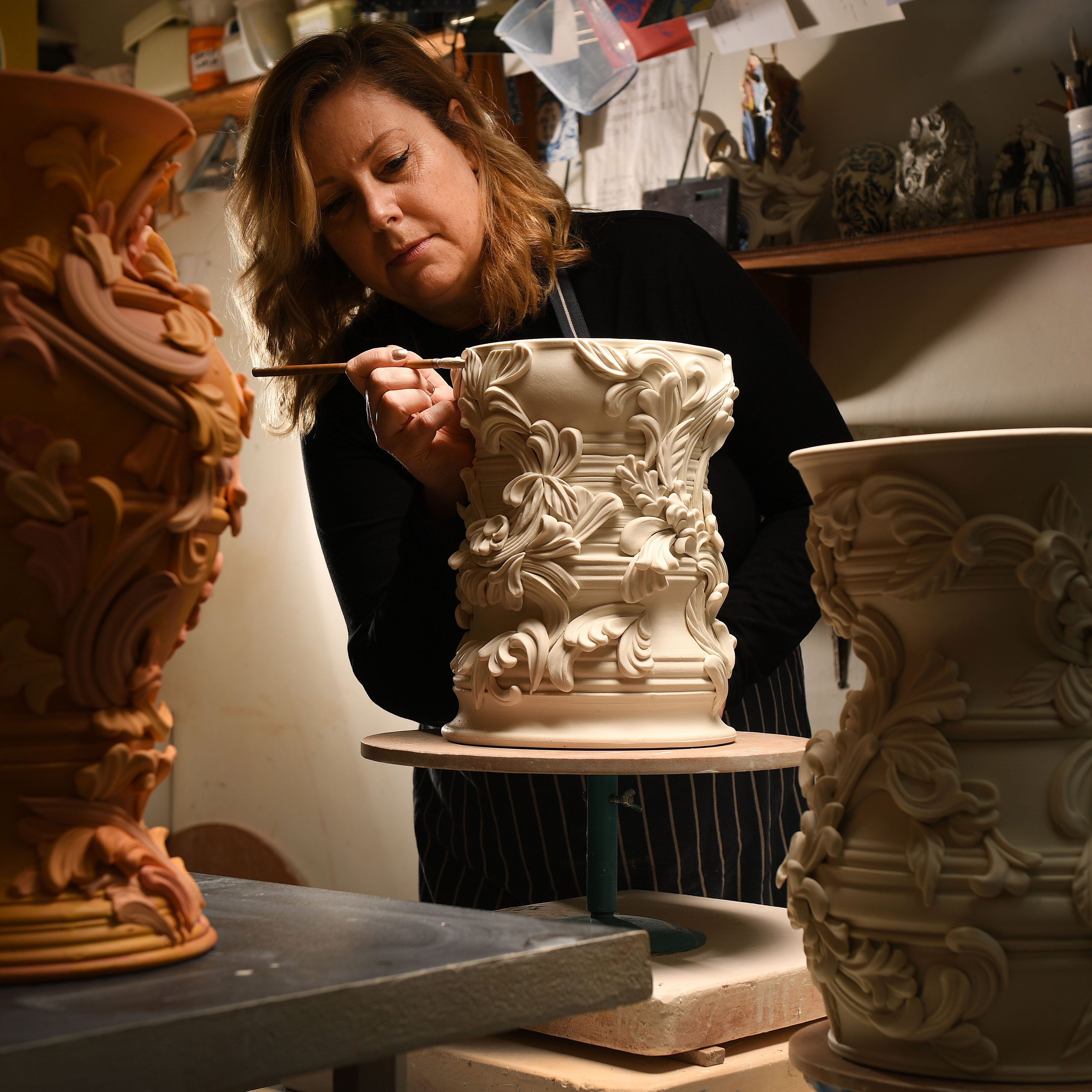
What do you find to be the most challenging aspect of your practice?
Some challenges are technical, often because I continue to look beyond my comfort zone and need to think about potential issues and resolve them before committing to a piece. The nature of ceramics and putting work through the firing process means there are no guarantees; opening the kiln is nerve wracking and there is always the potential for disaster! Being self employed can be challenging as everything relies on you, and if great opportunities present themselves simultaneously you put in really long hours to bring everything together on time. Resilience is vital to any artistic career, with ceramics there is the extra dimension of dealing with issues that occur in the kiln. Perhaps this is why people working with ceramics do become quite resilient and generously support each other with problem solving as everyone experiences a kiln disaster occasionally.
To date, what has been your ‘ceramic career’ high?
Being selected for AWARD at the 2025 British Ceramics Biennial is a significant high! I have applied on many previous occasions and it is really competitive, and I am honoured to be showing new work alongside a fantastic line up of makers. Showing at COLLECT with Vessel gallery is an incredible experience, it's such a significant show and there is a huge collective effort by makers and galleries every year to ensure the show is spectacular. Alongside making and exhibiting, it has been exciting to write about ceramics and be published by Crowood Press with my book 'Handbuilt Ceramics' in 2020. The publisher approached me during lockdown, which was why I was able to commit to such a big project. I connected with some amazing ceramicists as contributors who generously shared aspects of their respective practices and it was a lovely opportunity to discuss my practice alongside this. As a teacher of ceramics I am asked many technical questions so it was nice to be able to put straightforward, practical advice all in one place, with lots of step by step explanations.
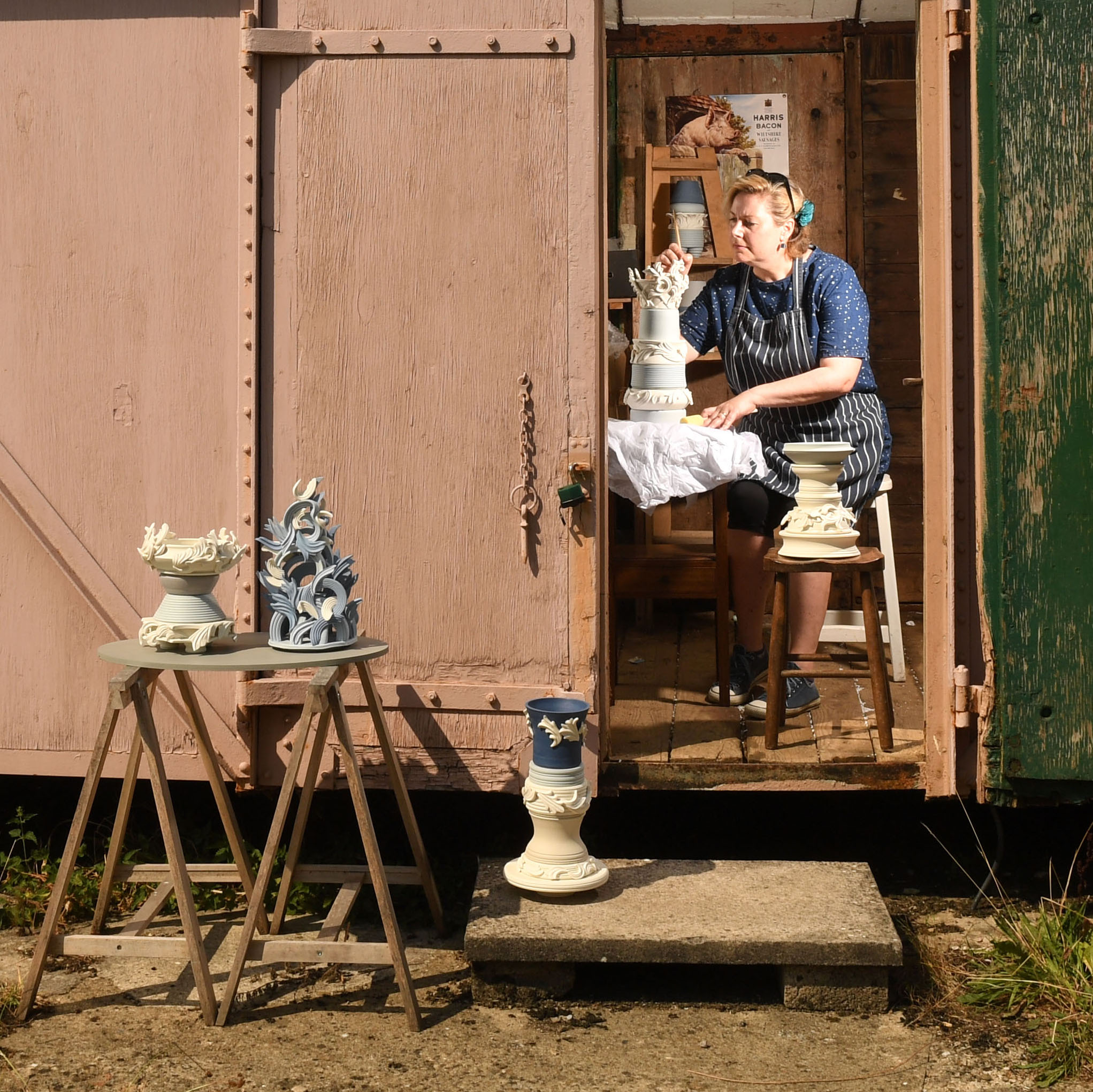
How do you feel about the state of British ceramics today?
The British Ceramics Biennial is a brilliant showcase for British Ceramics, providing a snapshot of what contemporary practice can be. Learning about ceramics is more popular than ever, meaning more people appreciate the complexities of working with this wonderful material. As a professional maker the challenge is always to balance income and opportunities, which is why events like Collect, the British Ceramics Biennial and galleries, competitions and exhibitions are so important to provide possibilities to show and sell work. In terms of detailed learning and gaining expertise, it can be challenging as the type of ceramics degree that I was lucky enough to study barely exists now. Many courses include other 3D materials or creative modules alongside ceramics which is great for broader practice but the depth of knowledge can be compromised which in turn can limit ways in which ideas can be expressed.
Which living ceramic artist do you most admire and why?
Phoebe Cummings works with raw clay; not only are her installation pieces incredibly well made and composed, but the vulnerability and impermanence of the work adds to its fragile beauty. Her approach to using clay in a world normally associated with firing and glazing is both brave and unique. It’s a perfect response to the question of sustainability as clay can almost be infinitely recyclable until the point of firing. That aside, it’s the quality of her craft skills, her compositions and ambition of installation which makes me want to visit every time she has work on show.
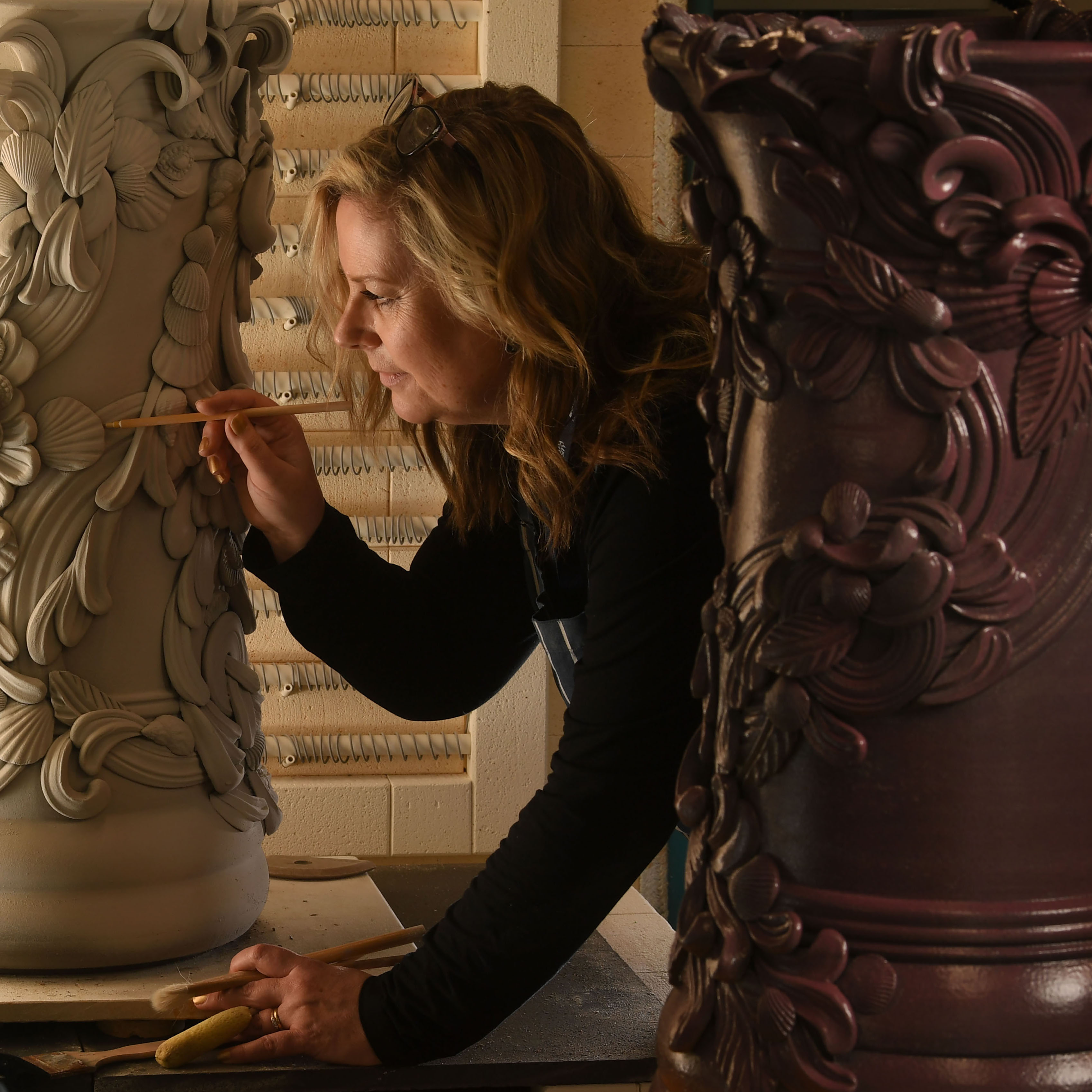
If you could collaborate with any artist, from any background, who would that be and why?
I love the paintings of Flora Yukhnovich, who is also inspired by the Rococo period. I love her palette, brush strokes and ambition for scale and find her approach inspiring and her work mesmerising. It is abstract enough to be ambiguous without losing sight of the references. In terms of a collaboration there could be a classic back and forth responding to each other’s work, or both taking the same inspiration and interpreting it individually, enjoying similarities and divergences. Being inspired by two dimensional work is a regular occurrence in my practice; elements of prints by Carl Pier & Jacques de la Joue were significant influences in the pieces made for the British Ceramics Biennial.
Can you share any future plans? Either ones set in stone or something you would love to make happen?
I am currently reaching the conclusion of a second book for Crowood Press, due to be published in 2026. It looks beyond the basics at more challenging approaches to working with clay, and considers wider aspects of ceramics practice including, resilience, professional practice and community. I have interviewed some exciting makers from around the world, who have generously contributed their wisdom and experience. I have recently moved into a new studio and am excited to settle in and make new work there. It is located within a beautifully converted site in rural Wiltshire, close to the National Trust Village of Lacock. It offers a much bigger space and quiet time away from the distractions and interruptions experienced when working from home. The light is excellent and I have a door that opens straight on to a landscaped area; I have my wheel next to it so it almost feels like I am throwing outdoors. There is a lovely community there so I am not lonely, but we are all busy working away at our passions so the feel is of quiet industry. I’m often there at weekends when it is very quiet – I disturbed a hare when I opened my door last week!
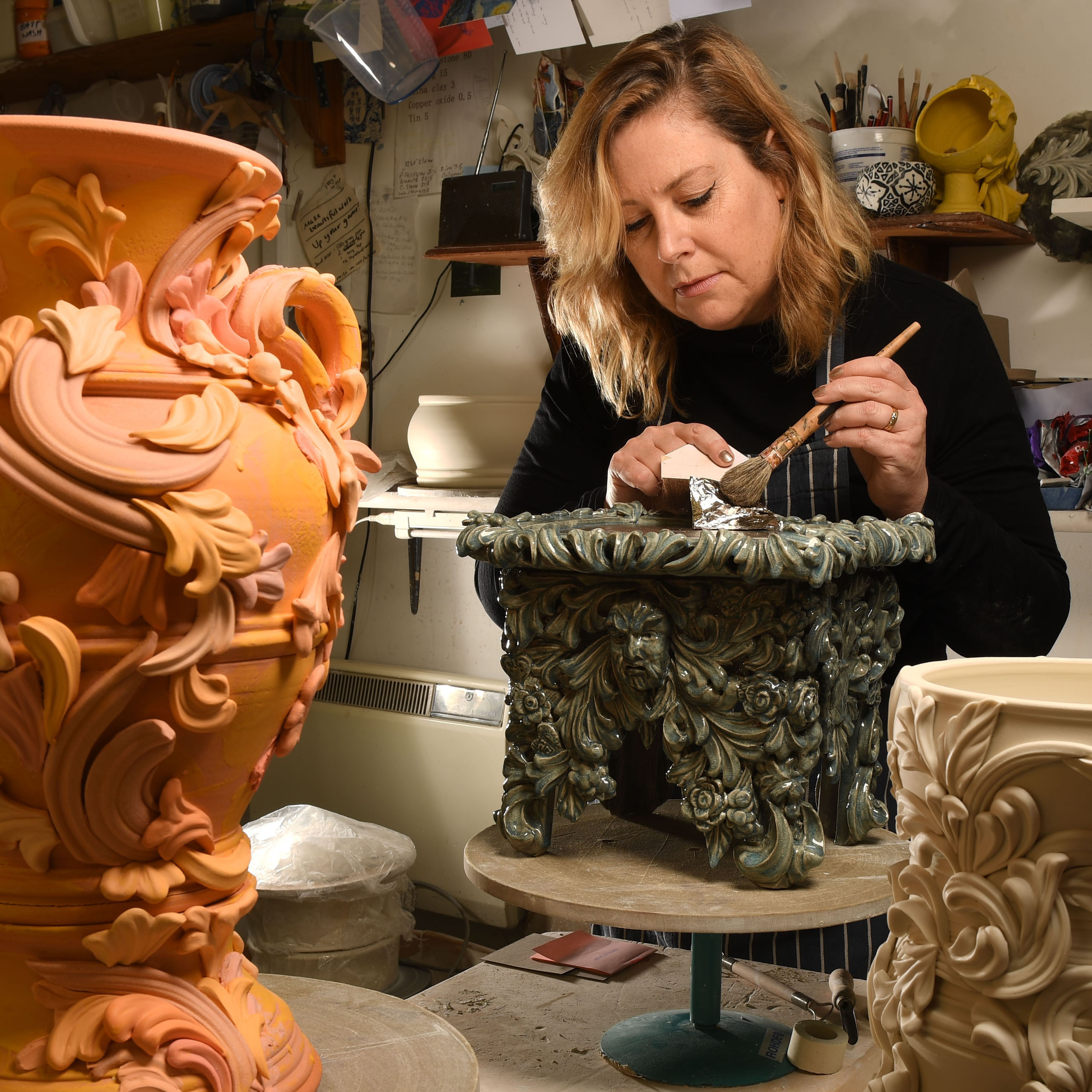
BCB Award Finalist Artist Showcase dates 19th September - 17th October 2025 | Further artworks by the artist

Cincture Wall Installation
Unique | H 84 cm W 162 cm D 9 cm | Porcelain
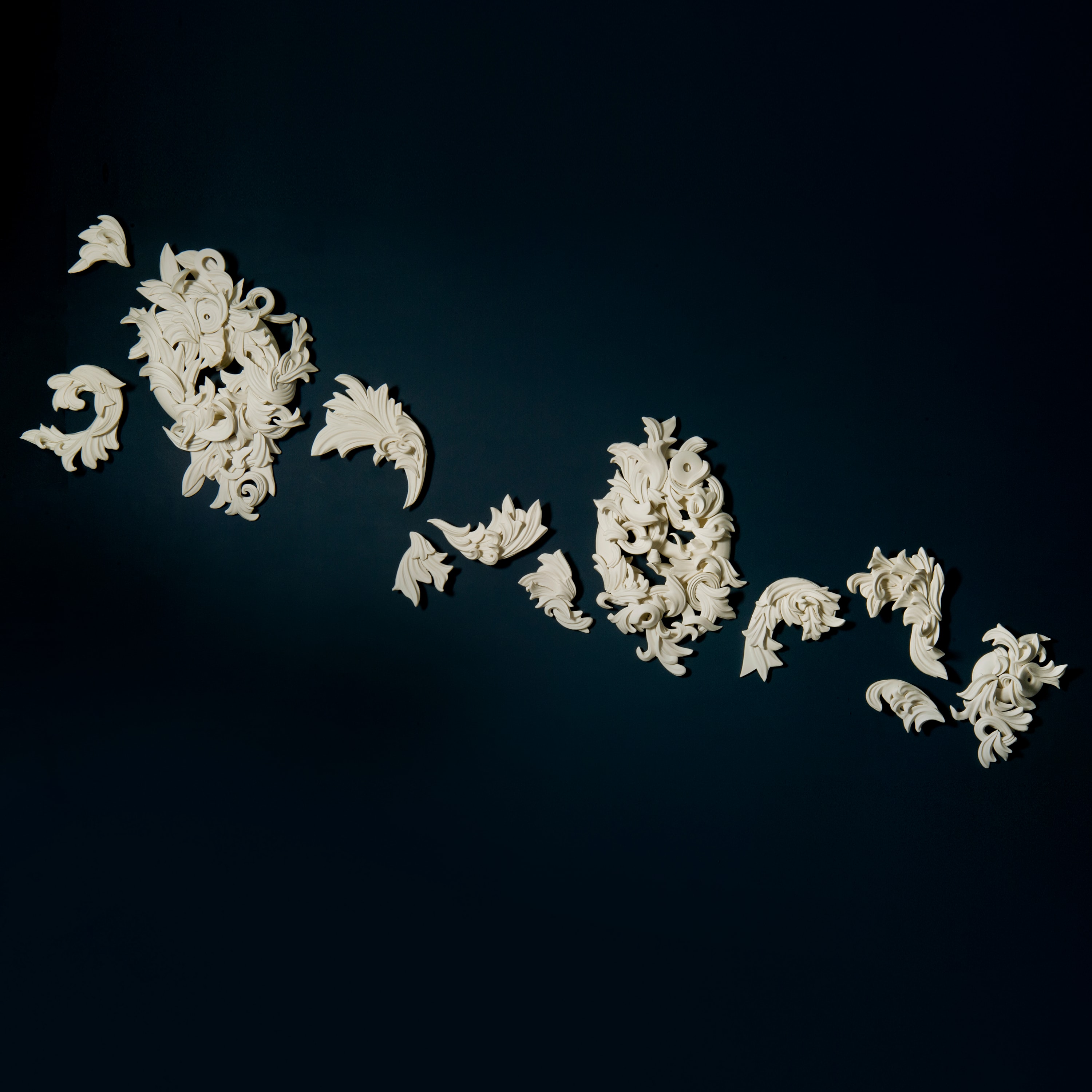
Gyratory I
Unique | H 67 cm W 51 cm D 36 cm | White St.Thomas clay
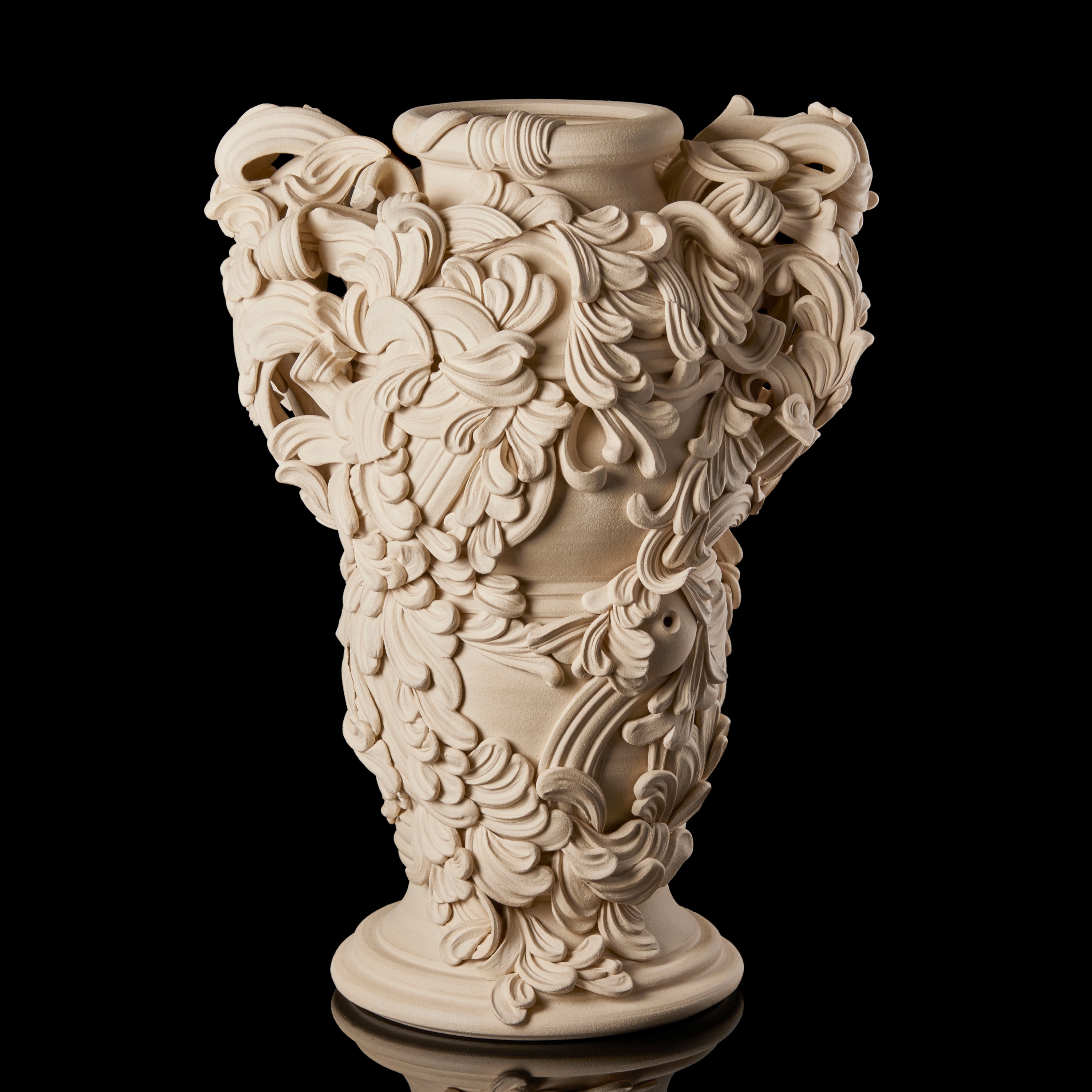
Gyratory IV
Unique | H 76 cm W 47 cm D 47 cm | White St.Thomas clay
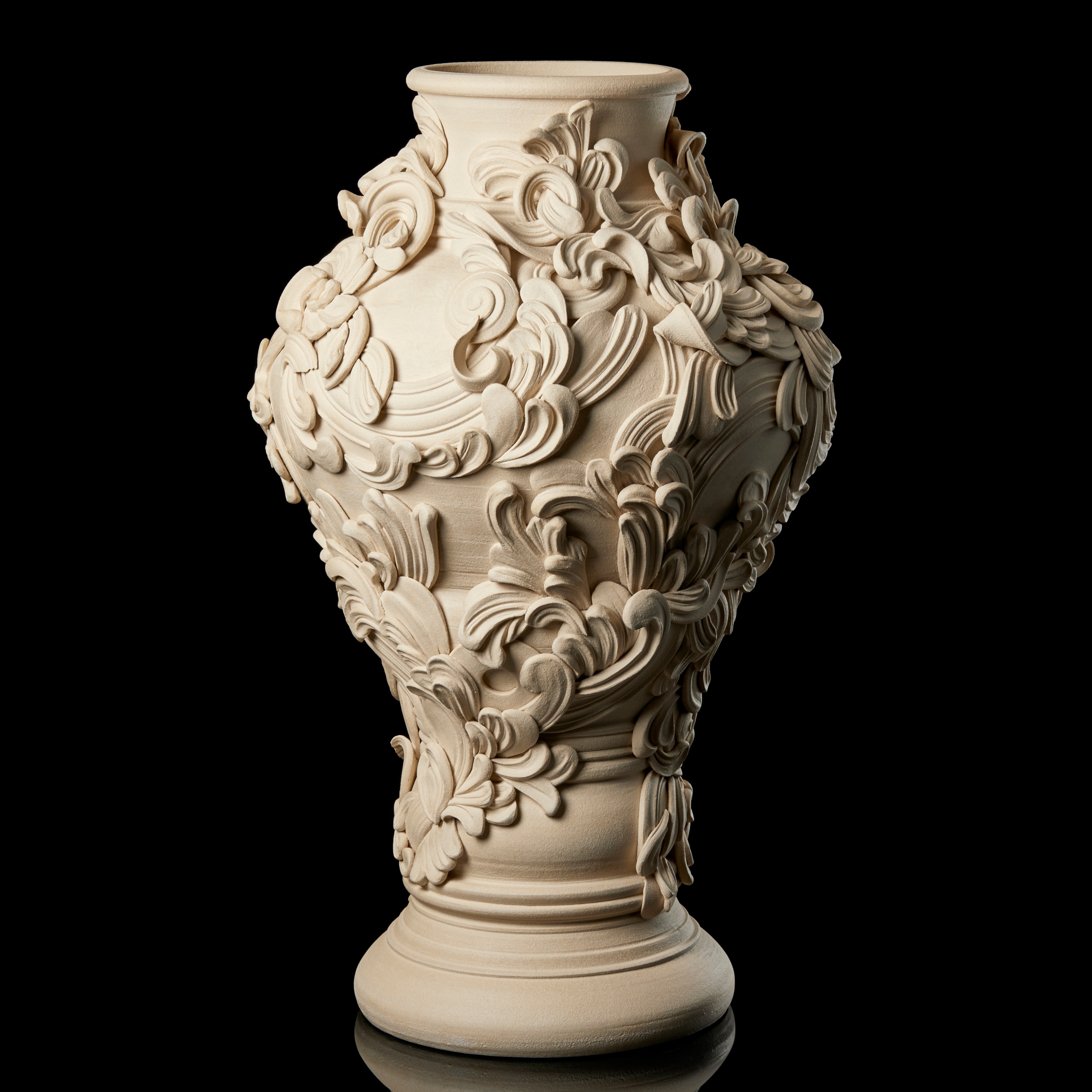
Gyratory II
Unique | H 74 cm W 39 cm D 37 cm | White St.Thomas clay
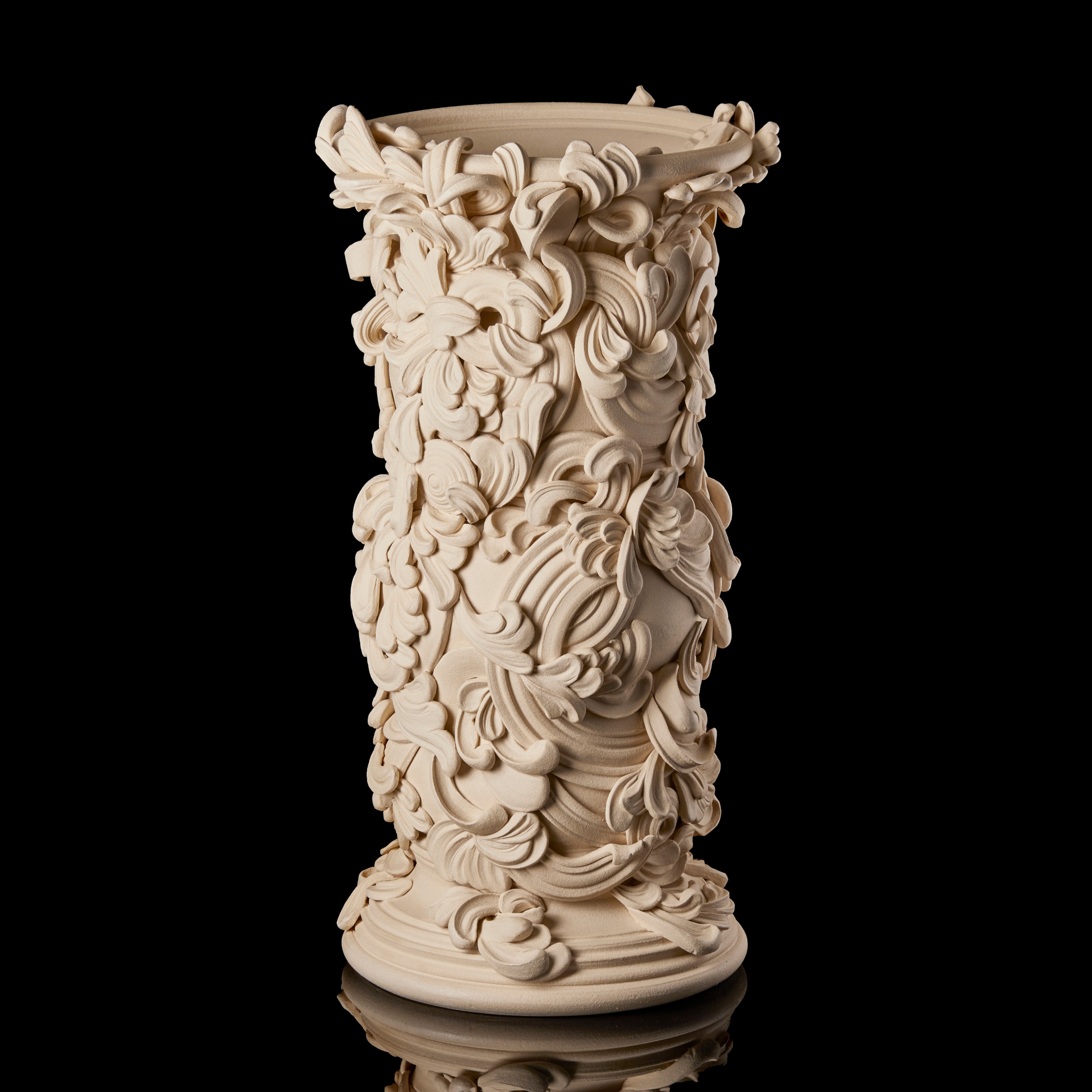
Abundance II
Unique | H 45 cm W 39 cm D 43 cm | White St.Thomas clay
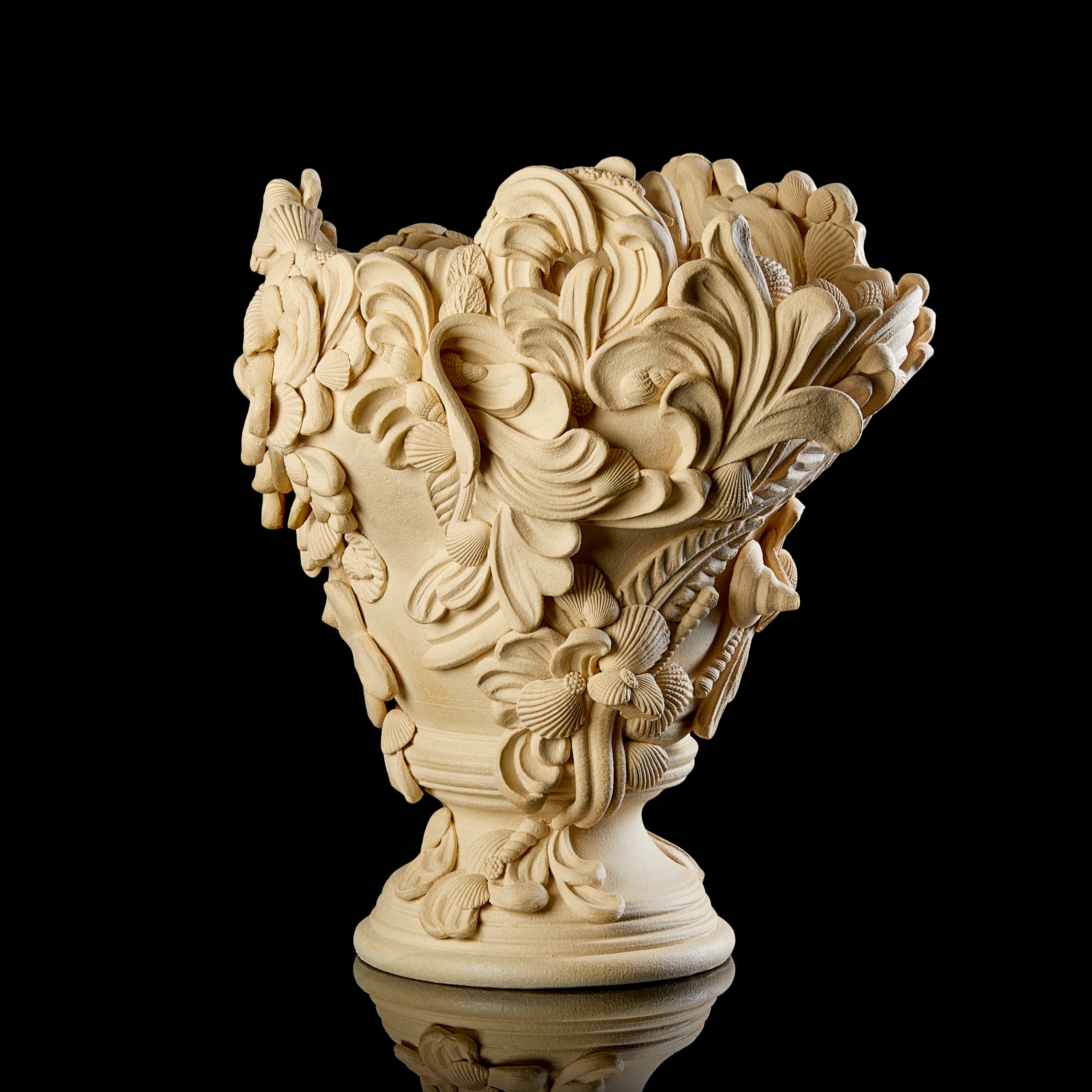
Gyratory III
Unique | H 37 cm W 33 cm D 34 cm | White St.Thomas clay
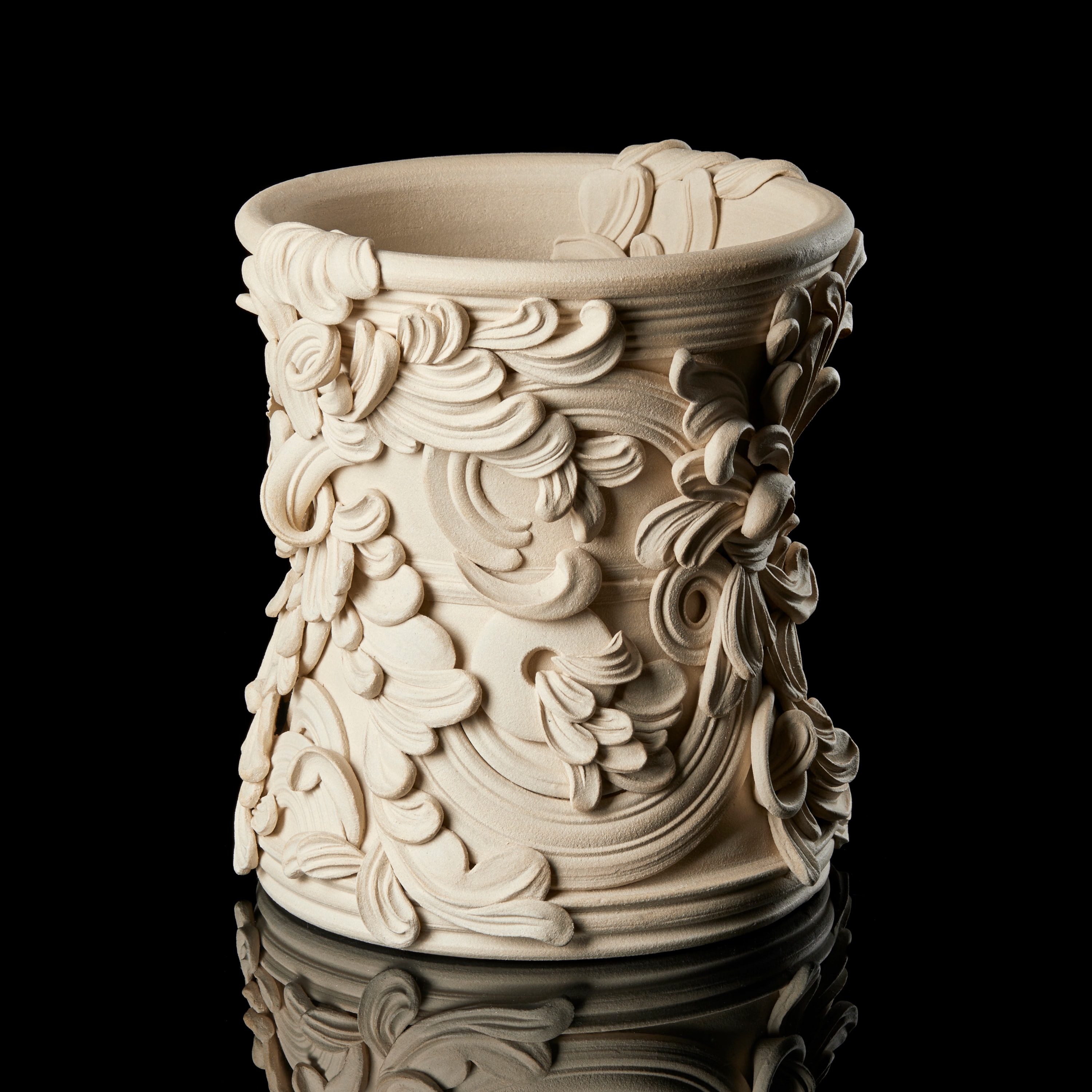
Peachy II
Unique | H 47 cm W 30 cm D 32 cm | White St.Thomas clay with coloured slip
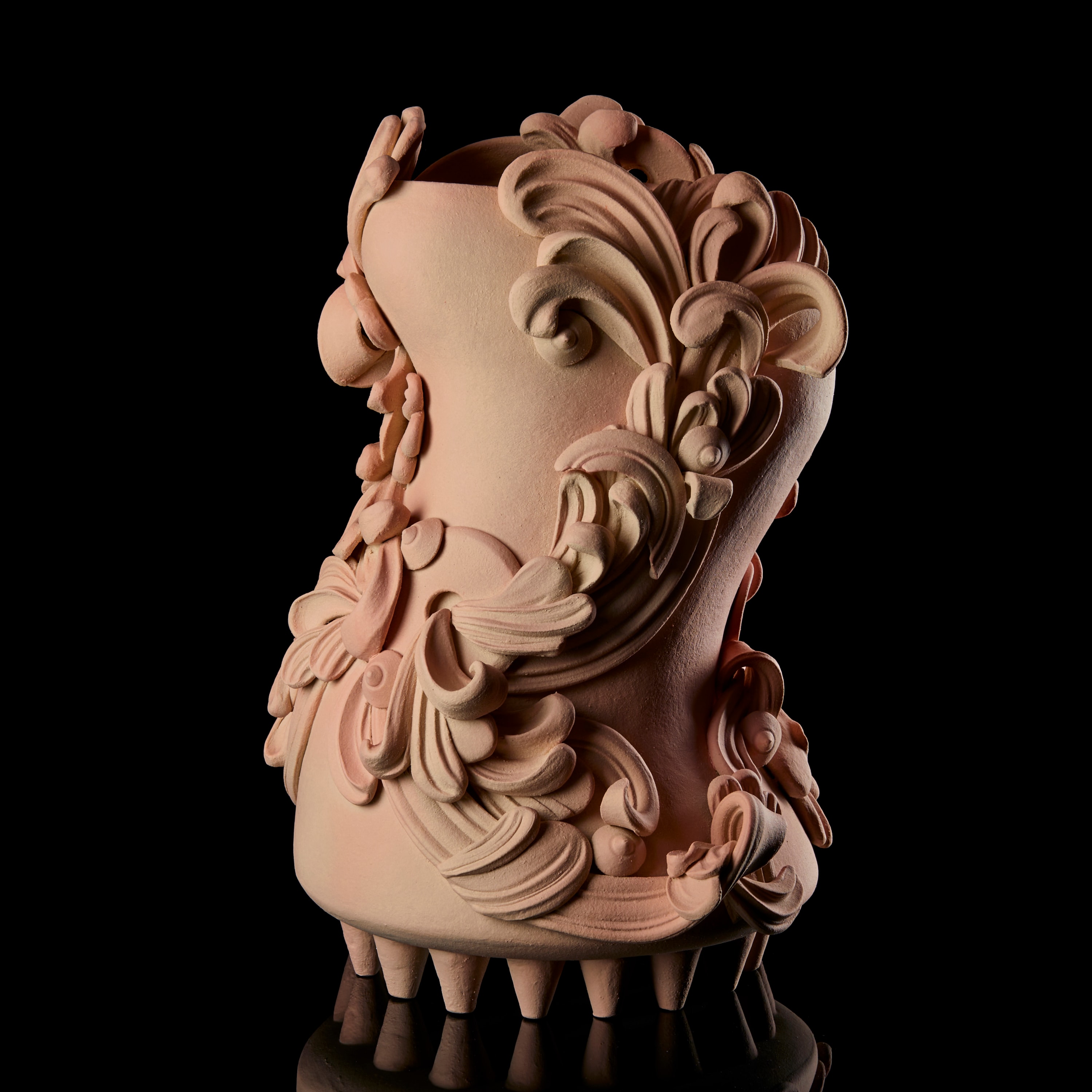
Columna I
Unique | H 75 cm W 43 cm D 43 cm | White St.Thomas clay with stoneware glazes
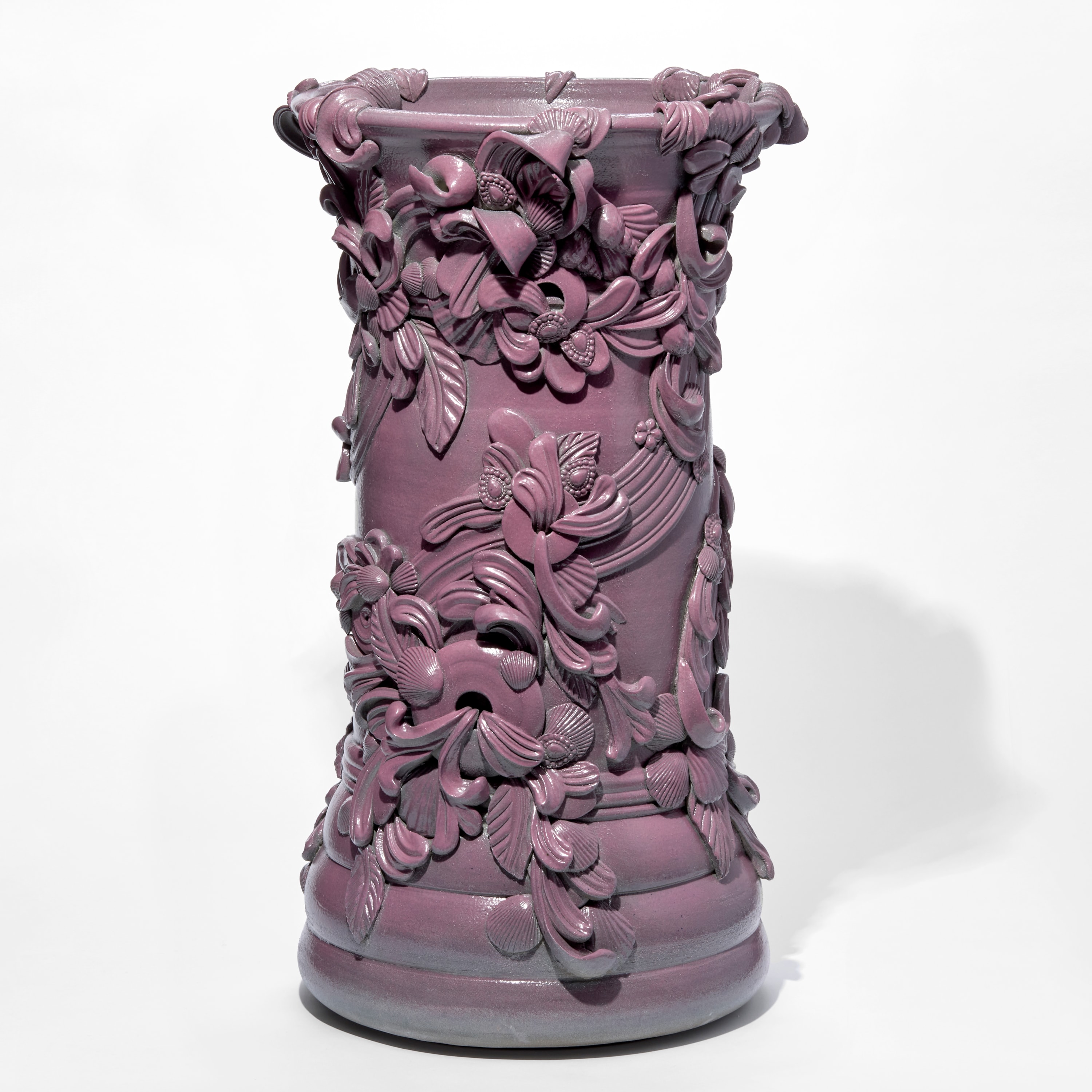
Marshmallow Urn
Unique | H 63 cm W 31 cm D 31 cm | White St.Thomas clay with professionally sprayed acrylic paint
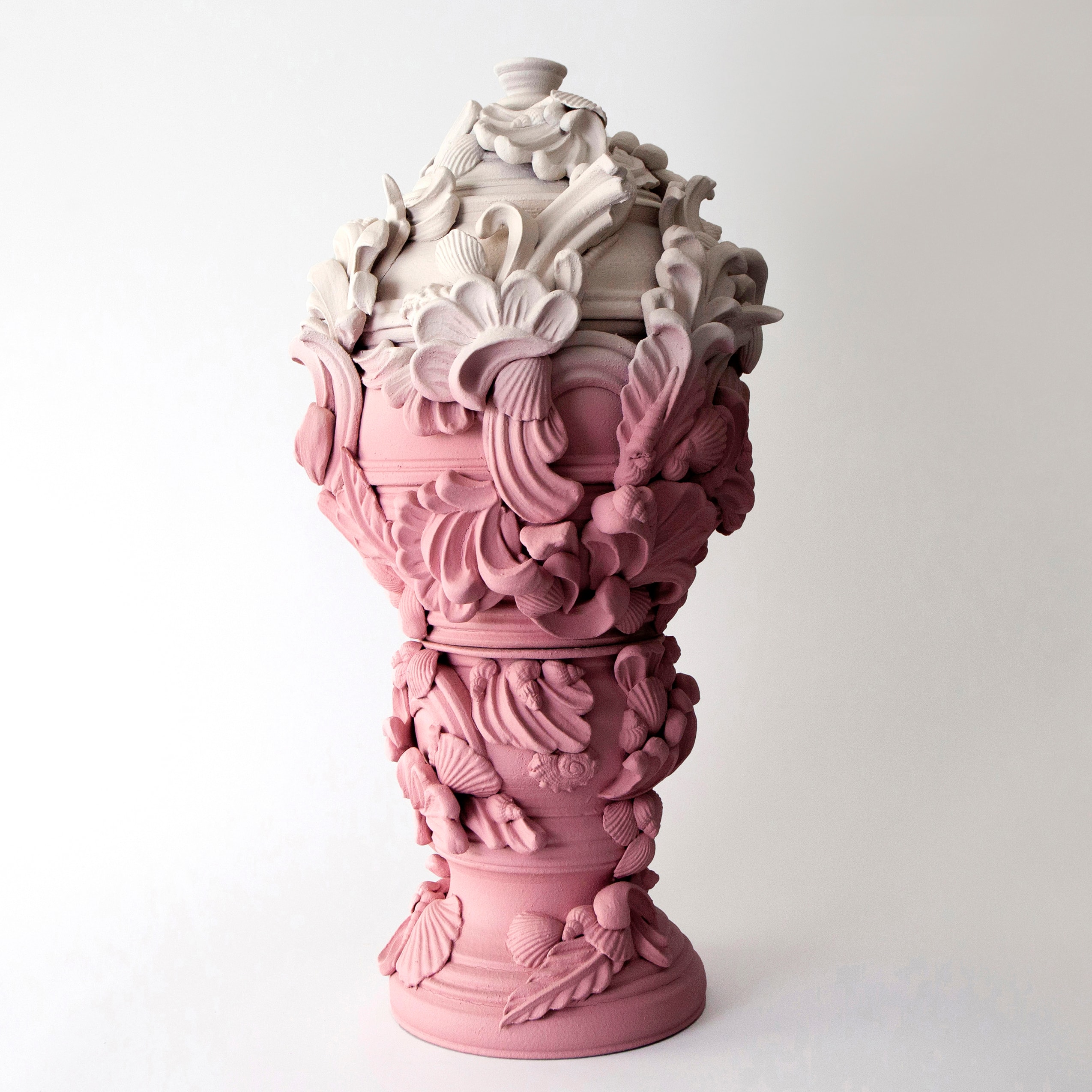
Artist portraits
by Russell Sach
Artwork photography
by Agata Pec and Jeni Meade

